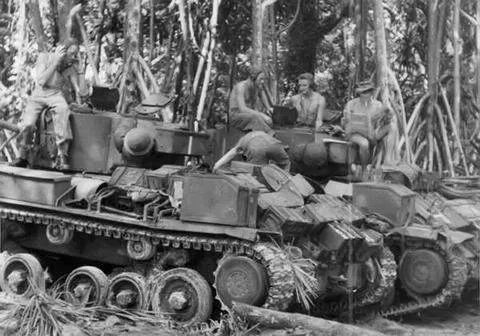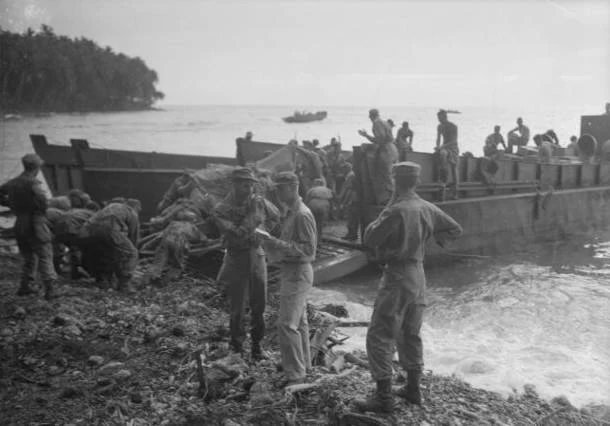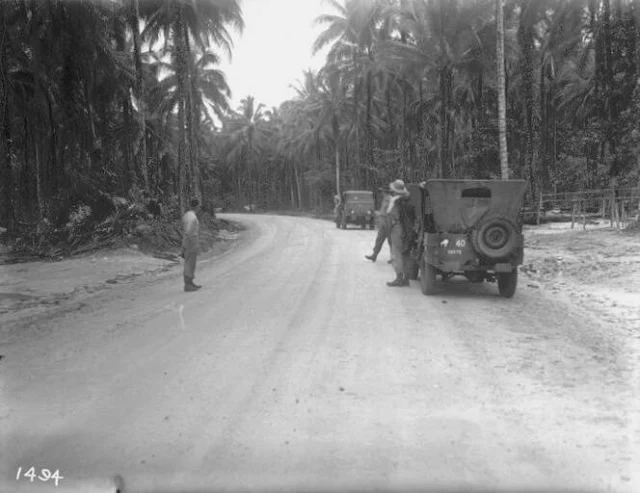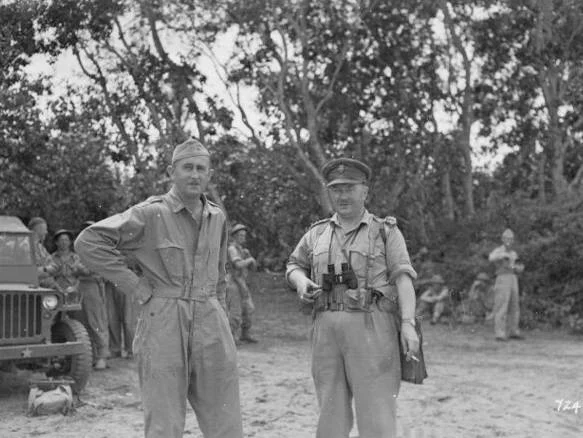When the 1st NZ Army Tank Brigade was broken up in December 1942, 2 Tanks Battalion Group was reorganized along the lines of an Armoured Regiment with two squadrons of Stuart Hybrids and one of Valentine Mk II and IIIs. It was designated to provide armored support for the 3rd Division then moving back to the Pacific, however, in June 1943 the requirement for armored support for 3rd NZ Division was reduced to a squadron sized unit and so 2 Tanks was broken up the bulk going to provide reinforcements for 2nd NZ Division while the rest were formed into the 3rd NZ Division Special Army Tank Squadron Group.
The Tank Squadron was dispatched to the Pacific two echelons. The first, including the Recce troop, left from Auckland for New Caledonia. The balance of the Squadron was sent to Guadalcanal where they were to train with elements of the 8th NZ Brigade. Once in Guadalcanal the Valentine III CS tanks were painted with a type of heat resistant paint and infantry-tank telephones were installed on the rear. They were also issued with a special track grouser. These were supposedly to help improve traction as the Valentines supplied to New Zealand had tracks suitable for sand only, but these grousers were never satisfactory and were not used operationally.
The five troop leader's tanks along with the rest of the tanks in the Squadron's sabre troops, were fitted with an infantry tank telephone box. The jack, headphone and microphone were all contained in a box that was originally fitted to the right rear mudguard in place of the tail smoke discharger. This box was later moved to a position alongside the petrol can rack. The jack was wired through the driver's junction box and the wire carried through a conduit on the right side and out through the tail lead light opening. The close support tanks had 100 yard leads for the microphone/headphone, while the other tanks had 15 foot leads.
Their stay in Guadalcanal was not without its problems. On the 13th of October during a demonstration to some visiting British Officers a 2-pounder HE round became stuck in the breech of a gun. The Squadron Workshops had to manufacture a special clearing rod to remove the round and then go through the painstaking task of modifying each round. This involved reducing the length of the case by 1/1000 of an inch, reassembling the round and chamber testing it.
A training exercise was conducted the 5th of November between the HQ Troop and some infantry. A Bren gunner would take up a concealed position along the proposed route of the tanks, fire on them when they came into view and see how long it took them to locate him. Unfortunately one tank gunner received numerous pieces of nickel and lead in his shoulder after bullet splash entered the turret of the tank under the mantlet. The Tank Squadron Workshops overcame this by fitting splash guard under the mantlet on the inside of the turret.
On one occasion some of the Squadron went up to Mt Stewart to demonstrate to General Barrowclough (Officer Commanding 3rd NZ Division) the use of the close support Valentine in the indirect fire role. Unfortunately the demonstration was not a success as it was difficult to observe the fall of the shot in the jungle. The crew of the tank were supposed to drop the range by 100 yards between shots but failed to follow the simple rule of checking the breech for obstructions before loading the next round. Thus the last shell ploughed into the hill behind the observation party and brought the demonstration to a hasty conclusion.
In February 1944 the Squadron was informed that it would be taking part in "Operation Squarepeg": the landings on Nissan Island in the Solomons Group. At this stage the Squadron was under the command of Major R J Rutherford, its former commander Major T C Wallace having being invalided out of the unit due to ill health. There was some confusion initially as to how many Landing Ship Tanks (LST) would be available but when the Americans informed 3rd NZ Division that only two could be released it became apparent that not all of the Squadron could participate in the initial landings. But greater shocks were to await them. At a planning conference before the landings the Squadron was informed that the tanks and crews would be travelling separately and would be landed at beaches some 200 yards apart. When asked what would happen if opposition was encountered and who would drive the tanks off the LSTs they were told that anyone could drive tank! When further protests were made they were told that if any more objections were heard the tanks would not go at all. It was only after some high-level, back-door lobbying that the matter was resolved, though the tanks would have to tow some US 90-mm AA guns ashore as compromise measure.
The Squadron set about preparing for its departure. 1 and 3 Troops under Lieutenants T K Evans and D Holden and two HQ tank were selected to go in the first wave under the command Rutherford. The rest of the Squadron was to follow in five days under the command of Captain C B Lewis. On the 11th of February they reported to the embarkation area at Kukum Beach. As if to add insult to injury they discovered that the planners had not allowed for the trailers carrying their reserve ammunition and there was no room for them in the LSTs. Major Rutherford saved the day by suggesting that these could be pushed onto the engine decks of the tanks and that is how they travelled to Nissan.
The landings by 14th NZ Brigade took place at first light on the 15th of February. The Squadron was landed mid-morning: 1 Troop on Green Beach at the southern end of the Tangalan Plantation and 3 Troop on Red Beach at the northern end of the Plantation. There was little opposition to the landings and soon a holiday atmosphere pervaded the beaches. This was rudely shattered at night when the Japanese bombed the beach-head and included the Squadron's B-Echelon in their target zone. The next day 3 Troop joined 1 Troop and together they moved south with 35th Battalion, breaking tracks for the infantry. While on the way down to Halls some personnel from the Squadron went down to the beach on the lagoon side of the island. While there they saw three or four people come onto the beach across the lagoon below the Mission and observe them closely. Some were for firing a 3-inch howitzer at them but by the time the tank got ready they were gone. However the first rounds for the Squadron were fired that day when two 2-pounders and a Besa were accidentally discharged. They bivouacked near the village of Halis that night.
On D+2 they continued their southerly sweep with the infantry, reaching South Point in the evening. In the falling light they saw what they thought to be a Japanese barge pulling away from the island. On D+3 infantry patrols working towards the Mission area encountered a deep ravine east of Torahatup. Major Rutherford inspected it and concluded that it was too steep and wide for the tanks to cross. He recommended that either a crossing place be blasted in the ravine or that the Squadron be transported across the lagoon to the Pokonian Plantation.
In an effort to find a way around the ravine Lieutenant Holden's Troop and an infantry platoon were sent along the southern beach in the afternoon. Their efforts were recorded for posterity by an official United States Cine reporter who was full of blood and fire and had been heard to exclaim, "I wanna take some shots of you guys crushing those little yellow b....s under your tracks." Some 70 Japanese had been reported to be in the Mission area so they could expect to encounter some opposition or be fired on from the cliffs. About 300 yards along the beach some natives were found sheltering under an overhang at the foot of the cliffs but they were too terrified to be of any help. About a mile further along the patrol encountered a peninsula of rocks jutting out into the sea, which blocked further progress. Leading infantry reported signs of Japanese in some caves so the tanks were ordered to fire at the cliffs to draw fire and flush out the enemy. The caves proved to be empty though there were signs of recent occupation. The patrol returned to South Point.
At first light on D+4 they received orders to proceed to Green Beach with all haste. Unfortunately one tank of 3 Troop became mechanically disabled en route and had to be left behind. Once across the lagoon they moved speedily down from the Pokonian Plantation to the 30th Battalion HQ at the village of Tanaheran on the west coast. Before moving off they left their reserve fuel and ammunition under the protection of some personnel from B-Echelon. The enemy had been reported in the Mission area and before 30th and 35th Battalion moved in the area was bombarded by the 3.7-inch howitzers of 144th Battery, RNZ Artillery. However, the Mission was occupied unopposed, with signs that the Japanese had made a hasty retreat.
The Squadron and parts of other units remained in the vicinity of the Mission, while the 30th Battalion returned to Tanaheran and here, blissfully unaware of an ominous presence nearby, took time out for a swim. Late in the afternoon A Company sent a patrol along the cliff top. They encountered some Japanese and in the resulting engagement two of the enemy were killed. When the rest were seen to scuttle down the cliff by way of a ravine the remainder of the company was sent for and the position was held all night.
On the morning of D+5 A Company moved back to Tanaheran and with the rest of the Battalion returned to their permanent bivouac area at the Pokonian Plantation. Later in the morning the Brigade Carrier Platoon under Captain Stronach arrived at Tanaheran to reconnoiter a suitable site for the Brigade HQ. To all intents and purposes the area was clear of the enemy so Stronach's men decided to have a swim before lunch. One man wandered over to the cliffs and as he did so a shot rang out. Two of the sergeants gathered together some men to investigate and were met with a hail of machine gun fire which wounded two men. Stronach formed a cordon around the spot and when attempts to rescue one man proved fruitless he realized that he was opposed by a considerable force.
Just before 2.00 pm the Squadron's Liaison Officer, Captain L F Brooker, called the Squadron to say that some Japanese had been encountered at Tanaheran and that two tanks could be employed in the area. At the same time the Squadron's B-Echelon managed to get through to say that they were also under attack. Major Rutherford ordered all tanks to a state of readiness while he and some other Officers set off on the backs of two tanks from 1 Troop under the command of Lieutenant Evans and Sergeant R H H Beetham. At this stage the United States Cine Reporter showed up again and asked what was going on? To which Major Flint replied, "You've got your chance now, mate, the Japs are attacking our B-Echelon and we're going down to rescue them." He muttered, "Goddamit, I must get some more film" and promptly disappeared down the track never to be seen again.
Once at the village they contacted Captain Brooker, Captain Stronach and an Officer of the MMG Company that had arrived to help. A plan was made for four Vickers guns to be set up on the east side of the village to give covering fire through the trees while the tanks were sent into the enemy occupied area. The time was about 2.30 pm. The enemy fired intermittent rifle and mortar fire throughout this period. Half an hour later Major Rutherford felt that the tanks were operating too far to the left. He crawled forward, contacted Lieutenant Evans over his infantry phone and guided him onto a fresh line. Major Rutherford returned and called up 3 Troop and the rest of the tanks.
At 3.45 pm 14th and 15th Platoons of D Company, 30th Battalion, under a Major Bullen arrived to relieve Stronach's men. Until their arrival the area had been held by some 14 to 15 men from the Carrier Platoon, the four MMG teams and the two tanks of the Squadron. Shortly after this Lieutenant Holden an Corporal H Johns arrived. They found themselves in a clearing with a lot of people milling around. Trooper F G Aldrich decided to try to find out what was going on and climbed out of Corporal Johns' tank. Just then some bullets struck a tree behind him giving him the impression that they were surrounded. He dived under the tank where he was joined by some others. Reaching up he got hold of the tank telephone and learned from Corporal Johns that they had been ordered forward and to get back inside. So he immediately scrambled over the engine deck and back into the turret, and along with Holden's tank they set off into the fray. The three other tanks arrived about this time but they were retained outside the village near the north- eastern corner. Then Sergeant Beetham's tank came out carrying the wounded man. Apparently in trying to protect him Evan's tank had run over a branch on which he lay and in the act had lifted him onto Beetham's tank. The tanks continued to spray the area with all weapons while those in support concentrated Besa, canister and HE on suspected sniper posts in the higher levels. One tank even engaged in the practice of tree felling to deal with one sniper by firing a HE shell with cap on into the base of the suspect tree.
At 5.45 pm Major Bullen decided to direct 3-inch mortar fire onto the enemy to enable his company to reorganize and launch an assault. Evans' and Holden's Troops were withdrawn to the B-Echelon position north of the village covered by the other three tanks, which joined them shortly afterwards. Here all tanks replenished and stood by. The mortar fire fell first on the village and then moved back towards the Japanese positions in the gardens by the cliffs. This enabled the infantry to get closer to the Japanese but the fire seemed just as intense as before. In the fading light the infantry were ordered to fix bayonets and, under a barrage of grenades, they carried the position. Lieutenant Holden's tank was guided to a position where a pocket of Japanese were believed to be but they were all dead. A further 8 Japanese were wiped out by a section of 16th Platoon on the beach below, after they had escaped over the cliff edge and tried to make their way northwards. A total of 52 dead Japanese were found in the area the next day.
On D+7 the Squadron made their way back to the Tangalan Plantation - by way of the Pokonian Plantation - to join with the other tanks that had arrived on D+5. Major Rutherford was riding on the lead tank and at one point suddenly ordered his driver to halt. At which point he leapt off and rushed into the jungle. In the ensuing confusion, turrets were traversed to cover him, Thompson SMGs and pistols drawn. Rutherford then reappeared carrying some fresh limes that he had seen growing on a tree! Flap over.
That
was the only combat the Squadron was to see. It returned to New Zealand, along
with the rest of 3rd NZ Division, later in 1944. Manpower shortages made it
impossible to maintain both the 3rd and 2nd NZ Divisions in service as well as
Navy and Air Force units.
 |
| Tanaheran Village from the Squadron's positions looking towards the Japanese positions taken the day after the hostilities. |
 |
| Lt T K Evan's tank backing onto the LST at Kukum Beach, Guadalcanal on the 11th of February 1944. The letters TL can be seen on the tank telephone box on the right. |
 |
| The troop sergeant from 3 Troop entering the Tangalan Plantation on Nissan Island on the 15th of February 1944 towing one of the U.S. 90 mm AA guns. |














































